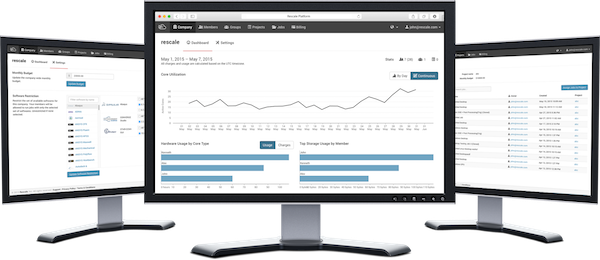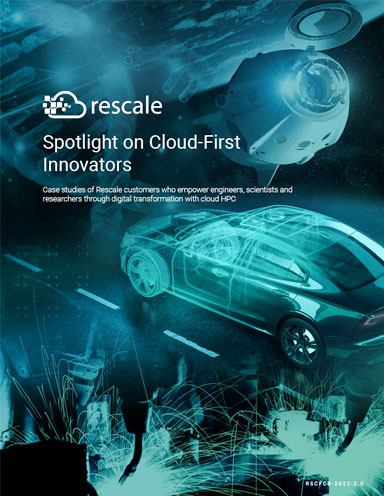The Connected Workstation: More Than the Sum of its Parts
SaaS-style simulation apps and on-demand HPC change the role of the classic workstation.

Rescale launches on-demand HPC infrastructure for simulation users under its ScaleX product line. Image courtesy of Rescale.
Latest News
October 10, 2019
The modern workstation is a connected hub, a box with invisible threads to the cloud. For sure, the physical machine has a finite number of computing and graphics cores, with finite memory and storage. But the prevalence of high-bandwidth connections and on-demand computing makes the box capable of much more than what’s listed in the system specs. What’s also fueling this new use of the workstation is the growing list of software developers adding cloud-enabled features to their flagship design and simulation products.
Cloud-Augmented Simulation
A household name in simulation software, ANSYS launched its simulation-centric, on-demand computing services, dubbed ANSYS Cloud, this February. It came with the introduction of a flexible, pay-per-use licensing model, called ANSYS Elastic Licensing, to make it feasible to run multiple instances of simulation in the cloud. This has been a need for many firms in engineering that want to perform design of experiment (DOE) studies, to analyze dozens or hundreds of design variants simultaneously to compare the weakness and strength of each.
“ANSYS Cloud is gaining significant momentum following its initial release, with our customers seeing immediate benefits from its increased simulation throughput and unequaled business agility,” says Navin Budhiraja, VP and GM of cloud and platform at ANSYS. “Incorporating ANSYS Electronics Desktop into the latest version of ANSYS Cloud allows broader customer access to on-demand HPC, greatly enhancing product quality and accelerating speed to market.”
 ANSYS Cloud, built on Microsoft Azure, provides instant access to on-demand HPC in the cloud directly from within ANSYS applications. Image courtesy of ANSYS.
ANSYS Cloud, built on Microsoft Azure, provides instant access to on-demand HPC in the cloud directly from within ANSYS applications. Image courtesy of ANSYS.Around the time Autodesk began the migration from perpetual desktop software to subscription-based software, the company also began adding cloud-enabled features to its core products. In core products such as Autodesk Inventor or AutoCAD, the cloud-enabled features may not be noticeable, but in graphics- and simulation-heavy programs, they make a difference in terms of the speed with which certain tasks are completed. Offered under the brand Autodesk Cloud Services, they are integrated into its Autodesk Fusion 360 CAD-CAM-CAE suite, the modeling and animation package Autodesk 3ds Max, the building information modeling (BIM) program Autodesk Revit and more.
Different from software as a service (SaaS) products, Autodesk software in general requires a thick client to be installed on the workstation. But inside the software, users can access on-demand cloud services to accelerate rendering or simulation jobs with additional compute power for a modest fee.
On-Demand HPC and Apps
Rescale, based in San Francisco, was founded with the idea that there’s a need for on-demand high performance computing (HPC) that specifically caters to simulation users. Now it its eighth year, the company offers ScaleX (Pro, Developer and Enterprise Editions), a web-accessible interface to set up and execute simulation. In partnership with ANSYS and Siemens, it offers ANSYS and Siemens simulation software users the option to run simulation on Rescale’s remote computer infrastructure. In addition to CPU cores, it offers access to GPU cores, including NVIDIA Volta and Tesla GPU cores joined via NVIDIA NVLink technology.
In 2013, the Ohio Supercomputing Center (OSC) and its partners launched AweSim, an initiative to “develop cloud-based manufacturing simulation applications sold through an e-commerce marketplace” (“AweSim: Boosting Manufacturing Competitiveness,” OSC Annual Research Report 2013, https://www.osc.edu). This exemplifies the company’s faith in the growing use of cloud-hosted, web-accessible simulation applications.
The AweSim catalog currently features a powder-bed fusion additive manufacturing (AM) simulator app, a heat sink analysis app, fixed-wing UAV analysis app, a datacenter cooling simulator app, and more. Whereas previously some users may have been prevented from running such analysis due to the limited computing resources in their workstation, AweSim’s on-demand approach lets workstation users access the apps from the cloud and run them on OSC’s infrastructure for a reasonable fee.
“Industrial users can access apps on-demand and have flexibility with the pay-as-you-go pricing structure, which provides companies with unparalleled ease of access to high performance computing resources that may otherwise be unattainable,” writes AweSim in its FAQ page.
Workloads Beyond the Workstation Capacity
With the need to employ artificial intelligence (AI) to parse IoT datasets and simulate autonomous vehicles’ decision making, the analysis workload is quickly outpacing the cyclical release of new workstations with added horsepower. Therefore, traditionally workstation-centric vendors have begun offering on-demand HPC to address the new phenomenon.
Windows OS giant Microsoft is actively seeking partners to deploy on-demand HPC workloads on its Azure cloud infrastructure. The company specifically targets deep learning (AI-driven analysis), simulation, rendering, and visualization.
“Computational Fluid Dynamics (CFD) simulations require significant compute time along with specialized hardware. As cluster usage increases, simulation times and overall grid use grow, leading to issues with spare capacity and long queue times. Adding physical hardware can be expensive, and may not align to the usage peaks and valleys that a business goes through. By taking advantage of Azure, many of these challenges can be overcome with no capital expenditure,” Microsoft points out in its product homepage for Azure for simulation.
With the same anticipation for simulation users, simulation software maker Altair began offering private cloud solutions, dubbed HyperWorks Unlimited. The physical appliance version is fully configured with simulation software, ready to augment workstation users who need additional computing power to address peak-time workloads beyond the desktop machine. In addition to the physical appliance, Altair also offers HyperWorks Unlimited as a virtual appliance, a remote cloud solution.
The classic workstation’s look is noticeably changing, with the introduction of all-in-one machines and touch-enabled tablets to its variety. Perhaps the less noticeable change is the computing paradigm, in which on-demand apps and remote clouds are an extension of the workstation itself.
More Dell Coverage

More NVIDIA Coverage
Subscribe to our FREE magazine, FREE email newsletters or both!
Latest News








